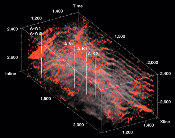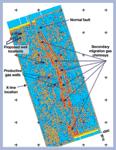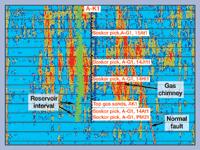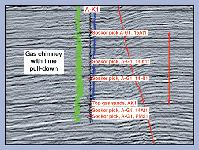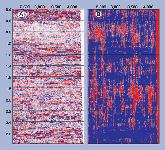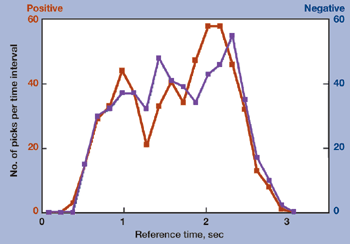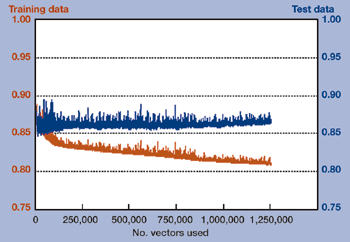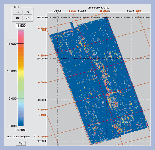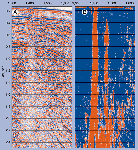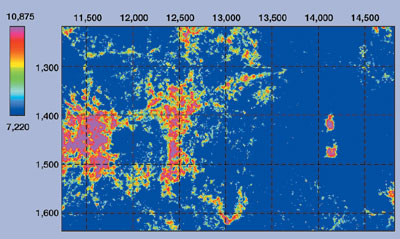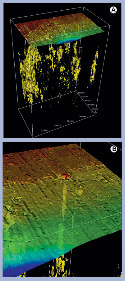Using gas chimneys as an exploration tool
EXPLORATIONUsing gas chimneys as an exploration toolPart 2 – Field case histories are discussed that use the principles of gas chimney identification and interpretation that were presented in Part 1.F. Aminzadeh, dGB-USA, T. Berge, Forest Oil Co., P. de Groot, dGB BV, and G. Valenti, AGIP
South African Example Africa has three extensive, thick-sectioned deltaic systems on its west coast. Of these, the Congo and Niger deltas have major hydrocarbon resources. The Orange River delta is less explored, but has gas and oil discoveries that indicate its potential. These discoveries point to at least three hydrocarbon systems in the area: 1) in-graben deposits of the early rift succession, e.g., the AJ1 oil well (discussed below); 2) late rift, Kudu-type (gas); and 3) the Albian-Aptian drift succession (gas). The deepwater deltaic portion has not been drilled, nor has its potential been assessed. The focus here is on a 312-km2, 3-D seismic survey in Block 2A, centered on a gas discovery, the AK1. This well allowed a detailed, first look at a small part of the delta. The original discovery well was plugged and abandoned, since it was thought to be a noncommercial structural trap. The 3-D survey showed that the field, designated Ibhubesi, is in fact a giant stratigraphic trap. The 3-D area might only cover a small southerly portion of the field, which may ultimately produce 15 Tcf of gas. Attribute processing and gradient analyses of the chimney volume clearly show gas accumulations in meandering, fluvial channels and other component facies of fluvial-deltaic systems. Fluvial channels, meander belts, crevasse splays, overbank deposits, tributary systems and deltas all can be identified in a 3-D view of the reservoir, Fig. 9.
A map view of this same 3-D volume is shown in Fig. 10, but this time showing (in red) the chimney cube attribute with seepage anomalies along the main fault. When viewed in a vertical section, these gas seepage anomalies are seen originating at the reservoir level and ascending to the surface, Fig. 11.
A four-well drilling program was undertaken to evaluate the field and prove up enough reserves for development. Three different anomalies were targeted; each well will test individual compartments with 300 to 900 Bcfg, yielding total reserves of 3.1 Tcfg. To date, the first three wells have been completed, and results have been highly successful. The AK2 well tested 30 MMcfgd and over 600 bpd of condensate from a 20-m-thick pay sand. FTP was 2,200 psi on a 3/4-in. choke. Neither significant pressure drawdown nor produced water was observed during the 12-hr test. Reservoir characteristics were better than expected: a clean and well-sorted matrix with average porosity of 22 to 27%. A deeper, 15-m gas-bearing sand of similar quality to the AK2 reservoir rock was targeted with well AV1, but the drillstring twisted off; that sand was subsequently penetrated in a sidetrack. This hole is interesting, because (besides confirming additional reserves) the lowest gas sand in AV1 is deeper than the lowest proven gas and highest known water in the AK1 well, clearly showing that it is a stratigraphic trap and separate reservoir. Thus far, results indicate that the initial vision of a giant, regional stratigraphic trap is being proven. Chimney analysis made a significant contribution to the interpretation and validation of earlier work. Fig. 12 shows how chimney analysis is integrated with conventional seismic processing and how seepage chimneys appear on a conventional reflection display.
Results after training the neural network with known and hand-picked chimneys and nonchimneys obtained the chimney probability shown in Fig. 13, which displays chimney output for inline 2800, compared against the original seismic. Fig. 14 displays the distribution picks from different time gates. RMS error for training and test data sets is shown in Fig. 15.
Fig. 16 shows time slices and highlights major chimney-like features. These features reach the seafloor along the fault trace, where there is a 40-m-high, ridge-shaped mound formed by a chemotropic community of organisms that live on methane seeps.
Gulf of Mexico Example In this case study, the prospect area is the continental shelf edge, western offshore Louisiana. Here, thick sand / shale sequences were deposited in OCS-to-upper-slope paleo-environments. Prospective targets range in age from early-to-late Pleistocene at about 13,500-ft subsea and shallower (C. Macintyrei to Trimosina A datum). Both gas and oil discoveries are predicted. Several producing Pleistocene fields are within about six mi of the area. The depositional setting is that of a mini-basin that was created by evacuation of a deeply buried salt sequence. One margin of the mini-basin is cut by a north-south trending fault. This fault system cuts the seafloor and, as seen on seismic, has raised zones on the seafloor in several places along its extent. Such features have been attributed to active seafloor gas vents. Chimney cubes were used to document the locations and subsurface extent of probable active gas leaks. The chimney cube method appears to provide good resolution of vertical distribution of gas and gas-saturated fluids within the 3-D volume. This distribution information, combined with structural mapping of prospective horizons, defines hydrocarbon-migration pathways and potential traps. A number of targets have been defined that lie updip to these zones of active, vertical hydrocarbon migration. Regionally, oil and gas production has been documented as taking place adjacent to active fluid-conductive faults. For that reason, documentation of active gas conduits using chimney cubes can help define gas prospects. In this GOM example, seismic chimneys – related to hydrocarbon-migration paths – are evident in the raw seismic data as a vertical disturbance of the response, Fig. 17A. The chaotic reflection pattern is characteristic of chimneys. In such areas, both energy and trace-to-trace similarity decrease. These chaotic reflections, attributed to chimneys, are highlighted in Fig. 17B. Fig. 18 shows the neural network chimney prediction at 1,000 ms.
Chimney shapes vary considerably. Some are cylindrical
(e.g., above a mound), while others are elongated or curved (e.g., along fractures, faults and
paleo-channels). Applying the trained network on a trace-by-trace and sample-by-sample basis yielded the
chimney prediction cube, Fig. 19. The detailed display reveals a possible mud volcano at the seafloor above a
seismic chimney.
Acknowledgment The authors appreciate the contributions of Statoil, specifically those of Roar Heggland and Paul Meldahl to the development of this technology and extensive insight and collaboration on earlier projects. The authors also acknowledge Herald Ligtenberg of dGB for his contributions to gas chimney processing. Forest Oil and Agip are thanked for granting permission to present their examples and data.
|
||||||||||||||||||||||||||||||||||||||||||||||||||||||||
- Applying ultra-deep LWD resistivity technology successfully in a SAGD operation (May 2019)
- Adoption of wireless intelligent completions advances (May 2019)
- Majors double down as takeaway crunch eases (April 2019)
- What’s new in well logging and formation evaluation (April 2019)
- Qualification of a 20,000-psi subsea BOP: A collaborative approach (February 2019)
- ConocoPhillips’ Greg Leveille sees rapid trajectory of technical advancement continuing (February 2019)

